ThisiscontentfromElsevier'sDrugInformation
Oseltamivir
Learn more about Elsevier’s Drug Information today! Get the reliable drug data and decision support you need to enhance patient safety through timely and accessible information.
General Dosing Information
Seasonal influenza virus
Novel influenza A viruses associated with severe human disease, including avian influenza virus
75 mg PO twice daily for 5 days.[31109] May consider extended courses for patients who remain severely ill after 5 days of treatment.[62315] [63866]
75 mg PO twice daily for 5 days.[31109] May consider extended courses for patients who remain severely ill after 5 days of treatment.[62315] [63866]
60 mg PO twice daily for 5 days.[31109] May consider extended courses for patients who remain severely ill after 5 days of treatment.[62315] [63866]
45 mg PO twice daily for 5 days.[31109] May consider extended courses for patients who remain severely ill after 5 days of treatment.[62315] [63866]
30 mg PO twice daily for 5 days.[31109] May consider extended courses for patients who remain severely ill after 5 days of treatment.[62315] [63866]
3.5 mg/kg/dose PO twice daily for 5 days is recommended by the American Academy of Pediatrics (AAP) based on pharmacokinetic data indicating that a slightly higher dosage is needed in this age group to achieve target drug exposure.[56854] [63520] The FDA-approved dosage is 3 mg/kg/dose PO twice daily for 5 days.[31109] May consider extended courses for patients who remain severely ill after 5 days of treatment.[62315] [63866]
3 mg/kg/dose PO twice daily for 5 days.[31109] May consider extended courses for patients who remain severely ill after 5 days of treatment.[62315] [63866]
3 mg/kg/dose PO twice daily for 5 days.[31109] May consider extended courses for patients who remain severely ill after 5 days of treatment.[62315] [63866]
3 mg/kg/dose PO twice daily for 5 days.[62315] [63520] May consider extended courses for patients who remain severely ill after 5 days of treatment.[62315] [63866]
1.5 mg/kg/dose PO twice daily for 5 days.[62315] [63520] May consider extended courses for patients who remain severely ill after 5 days of treatment.[62315] [63866]
1 mg/kg/dose PO twice daily for 5 days.[62315] [63520] May consider extended courses for patients who remain severely ill after 5 days of treatment.[62315] [63866]
75 mg PO once daily for at least 10 days after close contact and for up to 6 weeks during a community outbreak. Safety and efficacy have been demonstrated for up to 6 weeks in immunocompetent patients and safety has been demonstrated for up to 12 weeks in immunocompromised patients (efficacy has not been demonstrated).[25978] [31109] The duration of protection lasts for as long as dosing is continued. The CDC recommends a 7-day course after the last known exposure. For those vaccinated during an outbreak, a 2-week course is recommended. For control of outbreaks in long-term care facilities and hospitals, the CDC recommends chemoprophylaxis for a minimum of 2 weeks and up to 1 week after the last known identified case. High-risk patients may require prophylaxis during the entire influenza season.[62315] [63866] Oseltamivir treatment for 42 days has been efficacious in preventing influenza in 92% of those in residential nursing home settings during a flu outbreak; note that 80% of the residents had previously received influenza vaccination.[31109]
75 mg PO once daily for at least 10 days after close contact and for up to 6 weeks during a community outbreak.[31109] The duration of protection lasts for as long as dosing is continued. The CDC recommends a 7-day course after the last known exposure. For those vaccinated during an outbreak, a 2-week course is recommended. For control of outbreaks in long-term care facilities and hospitals, the CDC recommends chemoprophylaxis for a minimum of 2 weeks and up to 1 week after the last known identified case. High-risk patients may require prophylaxis during the entire influenza season.[62315] [63866]
75 mg PO once daily for at least 10 days after close contact and for up to 6 weeks during a community outbreak.[31109] The duration of protection lasts for as long as dosing is continued. The CDC recommends a 7-day course after the last known exposure. For those vaccinated during an outbreak, a 2-week course is recommended. For control of outbreaks in long-term care facilities and hospitals, the CDC recommends chemoprophylaxis for a minimum of 2 weeks and up to 1 week after the last known identified case. High-risk patients may require prophylaxis during the entire influenza season.[62315] [63866]
60 mg PO once daily for 10 days or for up to 6 weeks during a community outbreak.[31109] The duration of protection lasts for as long as dosing is continued. The CDC recommends a 7-day course after the last known exposure. For those vaccinated during an outbreak, a 2-week course is recommended. For control of outbreaks in long-term care facilities and hospitals, the CDC recommends chemoprophylaxis for a minimum of 2 weeks and up to 1 week after the last identified case. High-risk patients may require prophylaxis during the entire influenza season.[62315] [63866]
45 mg PO once daily for 10 days or for up to 6 weeks during a community outbreak.[31109] The duration of protection lasts for as long as dosing is continued. The CDC recommends a 7-day course after the last known exposure. For those vaccinated during an outbreak, a 2-week course is recommended. For control of outbreaks in long-term care facilities and hospitals, the CDC recommends chemoprophylaxis for a minimum of 2 weeks and up to 1 week after the last identified case. High-risk patients may require prophylaxis during the entire influenza season.[62315] [63866]
30 mg PO once daily for 10 days or for up to 6 weeks during a community outbreak.[31109] The duration of protection lasts for as long as dosing is continued. The CDC recommends a 7-day course after the last known exposure. For those vaccinated during an outbreak, a 2-week course is recommended. For control of outbreaks in long-term care facilities and hospitals, the CDC recommends chemoprophylaxis for a minimum of 2 weeks and up to 1 week after the last identified case. High-risk patients may require prophylaxis during the entire influenza season.[62315] [63866]
3.5 mg/kg/dose PO once daily.[56854] [63520] The duration of therapy is dependent on type of exposure: 7 days after the last known exposure; 2 weeks for those vaccinated during an outbreak; a minimum of 2 weeks and up to 1 week after the last-identified case for control of outbreaks in long-term care facilities and hospitals. High-risk patients may require prophylaxis during the entire influenza season.[62315] [63520] [63866]
3 mg/kg/dose PO once daily.[62315] [63520] The duration of therapy is dependent on type of exposure: 7 days after the last known exposure; 2 weeks for those vaccinated during an outbreak; a minimum of 2 weeks and up to 1 week after the last identified case for control of outbreaks in long-term care facilities and hospitals. High-risk patients may require prophylaxis during the entire influenza season.[62315] [63520] [63866]
Because of the lack of data in this age group, chemoprophylaxis is not recommended unless the exposure situation is judged to be critical.[62315] [63520] A variety of oseltamivir dosages have been safely used for influenza prophylaxis in infants in limited studies.[43072] [52863] [52865] [52866] A dosage of 1 mg/kg/dose PO twice daily for 10 days was effective in a small study of 13 neonates (mean gestational age 39 weeks [range, 36 to 41 weeks]) exposed to influenza H1N1; no patients developed influenza.[52865]
Because of the lack of data in this age group, chemoprophylaxis is not recommended unless the exposure situation is judged to be critical.[62315] [63520] A variety of oseltamivir dosages have been safely used for influenza prophylaxis in neonates in limited studies.[43072] [52863] [52865] [52866] A dosage of 1 mg/kg/dose PO twice daily for 10 days was effective in a small study of 13 neonates (mean gestational age 39 weeks [range, 36 to 41 weeks]) exposed to influenza H1N1; no patients developed influenza.[52865]
75 mg PO twice daily for 5 days, with longer courses (e.g., 10 days) considered for severely ill hospitalized patients or immunosuppressed patients. Clinical judgment and virologic testing should guide duration assessment. Oseltamivir is recommended for hospitalized patients as well as outpatients.[62336]
75 mg PO twice daily for 5 days, with longer courses (e.g., 10 days) considered for severely ill hospitalized patients or immunosuppressed patients. Clinical judgment and virologic testing should guide duration assessment. Oseltamivir is recommended for hospitalized patients as well as outpatients.[62315] [62336]
60 mg PO twice daily for 5 days, with longer courses (e.g., 10 days) considered for severely ill hospitalized patients or immunosuppressed patients. Clinical judgment and virologic testing should guide duration assessment. Oseltamivir is recommended for hospitalized patients as well as outpatients.[62315] [62336]
45 mg PO twice daily for 5 days, with longer courses (e.g., 10 days) considered for severely ill hospitalized patients or immunosuppressed patients. Clinical judgment and virologic testing should guide duration assessment. Oseltamivir is recommended for hospitalized patients as well as outpatients.[62315] [62336]
30 mg PO twice daily for 5 days, with longer courses (e.g., 10 days) considered for severely ill hospitalized patients or immunosuppressed patients. Clinical judgment and virologic testing should guide duration assessment. Oseltamivir is recommended for hospitalized patients as well as outpatients.[62315] [62336]
3.5 mg/kg/dose PO twice daily for 5 days, with longer courses (e.g., 10 days) considered for severely ill hospitalized patients or immunosuppressed patients. Clinical judgment and virologic testing should guide duration assessment. Oseltamivir is recommended for hospitalized patients as well as outpatients.[56854] [62315] [62336] [63520]
3 mg/kg/dose PO twice daily for 5 days, with longer courses (e.g., 10 days) considered for severely ill hospitalized patients or immunosuppressed patients. Clinical judgment and virologic testing should guide duration assessment. Oseltamivir is recommended for hospitalized patients as well as outpatients.[56854] [62315] [62336] [63520]
3 mg/kg/dose PO twice daily for 5 days, with longer courses (e.g., 10 days) considered for severely ill hospitalized patients or immunosuppressed patients. Clinical judgment and virologic testing should guide duration assessment. Oseltamivir is recommended for hospitalized patients as well as outpatients.[62315] [62336] [63520]
1.5 mg/kg/dose PO twice daily for 5 days, with longer courses (e.g., 10 days) considered for severely ill hospitalized patients or immunosuppressed patients. Clinical judgment and virologic testing should guide duration assessment. Oseltamivir is recommended for hospitalized patients as well as outpatients.[62315] [62336] [63520]
1 mg/kg/dose PO twice daily for 5 days, with longer courses (e.g., 10 days) considered for severely ill hospitalized patients or immunosuppressed patients. Clinical judgment and virologic testing should guide duration assessment. Oseltamivir is recommended for hospitalized patients as well as outpatients.[62315] [62336] [63520]
75 mg PO twice daily. Initiate therapy as soon as possible after first exposure to the confirmed or probable case. If exposure was time-limited and not ongoing, 5 days of treatment from the last known exposure is recommended. If exposure is likely to be ongoing (i.e., household setting), 10 days of treatment is recommended.[62315] [62337] [62338]
75 mg PO twice daily. Initiate therapy as soon as possible after first exposure to the confirmed or probable case. If exposure was time-limited and not ongoing, 5 days of treatment from the last known exposure is recommended. If exposure is likely to be ongoing (i.e., household setting), 10 days of treatment is recommended.[62315] [62337] [62338]
60 mg PO twice daily. Initiate therapy as soon as possible after first exposure to the confirmed or probable case. If exposure was time-limited and not ongoing, 5 days of treatment from the last known exposure is recommended. If exposure is likely to be ongoing (i.e., household setting), 10 days of treatment is recommended.[62315] [62337] [62338]
45 mg PO twice daily. Initiate therapy as soon as possible after first exposure to the confirmed or probable case. If exposure was time-limited and not ongoing, 5 days of treatment from the last known exposure is recommended. If exposure is likely to be ongoing (i.e., household setting), 10 days of treatment is recommended.[62315] [62337] [62338]
30 mg PO twice daily. Initiate therapy as soon as possible after first exposure to the confirmed or probable case. If exposure was time-limited and not ongoing, 5 days of treatment from the last known exposure is recommended. If exposure is likely to be ongoing (i.e., household setting), 10 days of treatment is recommended.[62315] [62337] [62338]
3.5 mg/kg/dose PO twice daily.[56854] [63520] Initiate therapy as soon as possible after first exposure to the confirmed or probable case. If exposure was time-limited and not ongoing, 5 days of treatment from the last known exposure is recommended. If exposure is likely to be ongoing (i.e., household setting), 10 days of treatment is recommended.[62337] [62338]
3 mg/kg/dose PO twice daily. Initiate therapy as soon as possible after first exposure to the confirmed or probable case. If exposure was time-limited and not ongoing, 5 days of treatment from the last known exposure is recommended. If exposure is likely to be ongoing (i.e., household setting), 10 days of treatment is recommended.[62315] [62337] [62338]
3 mg/kg/dose PO twice daily. Initiate therapy as soon as possible after first exposure to the confirmed or probable case. If exposure was time-limited and not ongoing, 5 days of treatment from the last known exposure is recommended. If exposure is likely to be ongoing (i.e., household setting), 10 days of treatment is recommended.[62315] [62337] [62338]
1.5 mg/kg/dose PO twice daily. Initiate therapy as soon as possible after first exposure to the confirmed or probable case. If exposure was time-limited and not ongoing, 5 days of treatment from the last known exposure is recommended. If exposure is likely to be ongoing (i.e., household setting), 10 days of treatment is recommended.[62315] [62337] [62338]
1 mg/kg/dose PO twice daily. Initiate therapy as soon as possible after first exposure to the confirmed or probable case. If exposure was time-limited and not ongoing, 5 days of treatment from the last known exposure is recommended. If exposure is likely to be ongoing (i.e., household setting), 10 days of treatment is recommended.[62315] [62337] [62338]
150 mg/day PO.
150 mg/day PO.
150 mg/day PO.
weighing more than 40 kg: 150 mg/day PO.
weighing 24 to 40 kg: 120 mg/day PO.
weighing 16 to 23 kg: 90 mg/day PO.
weighing 15 kg or less: 60 mg/day PO.
9 to 11 months: 6 mg/kg/day PO is the FDA-approved dosage; however, doses up to 7 mg/kg/day PO have been used off-label.
1 to 8 months: 6 mg/kg/day PO.
Term Neonates 14 days and older: 6 mg/kg/day PO.
Premature Neonates older than 40 weeks postmenstrual age and Term Neonates 0 to 13 days: Safety and efficacy have not been established; however, doses up to 6 mg/kg/day PO have been used off-label.
Premature Neonates 38 to 40 weeks postmenstrual age: Safety and efficacy have not been established; however, doses up to 3 mg/kg/day PO have been used off-label.
Premature Neonates younger than 38 weeks postmenstrual age: Safety and efficacy have not been established; however, doses up to 2 mg/kg/day PO have been used off-label.
Mild to moderate hepatic impairment: No dosage adjustment is needed.
Severe hepatic impairment: The safety and pharmacokinetics of oseltamivir in patients with severe hepatic impairment have not been established.[31109]
The following dose adjustments are recommended for adult patients with renal impairment. Dose adjustment recommendations are unavailable for pediatric patients; however, similar dose adjustments should be considered, particularly in pediatric patients receiving the adult dosage.[31109]
Influenza treatment
CrCl more than 60 mL/minute: No dosage adjustment is needed.
CrCl 31 to 60 mL/minute: 30 mg PO twice daily for 5 days.
CrCl 11 to 30 mL/minute: 30 mg PO once daily for 5 days.
CrCl 10 mL/minute or less, not undergoing dialysis: Use is not recommended.[31109]
Influenza prophylaxis
CrCl more than 60 mL/minute: No dosage adjustment is needed.
CrCl 31 to 60 mL/minute: 30 mg PO once daily.
CrCl 11 to 30 mL/minute: 30 mg PO every other day.
CrCl 10 mL/minute or less, not undergoing dialysis: Use is not recommended.[31109]
Intermittent hemodialysis (ESRD patients with CrCl 10 mL/minute or less)
For influenza treatment: 30 mg PO after every hemodialysis cycle; treatment duration not to exceed 5 days. The initial dose may be given immediately, with subsequent doses administered after each dialysis.
For influenza prophylaxis: 30 mg PO after alternate hemodialysis cycles. The initial dose may be given prior to the start of dialysis.[31109]
Continuous ambulatory peritoneal hemodialysis (ESRD patients with CrCl 10 mL/minute or less)
For influenza treatment: 30 mg PO immediately as a single dose.
For influenza prophylaxis: 30 mg PO immediately, then 30 mg PO once weekly.[31109]
† Off-label indication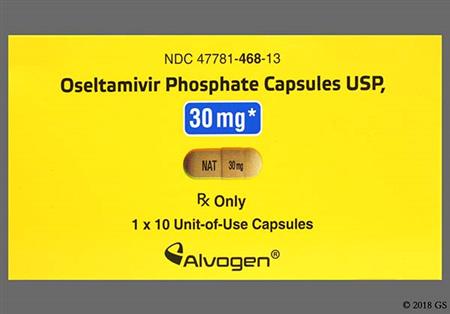
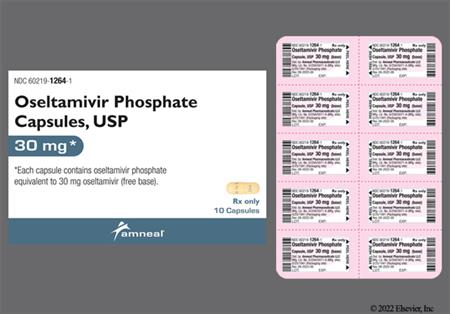
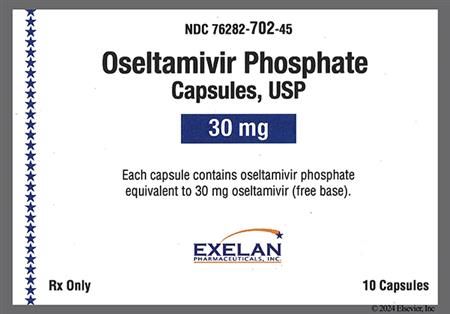
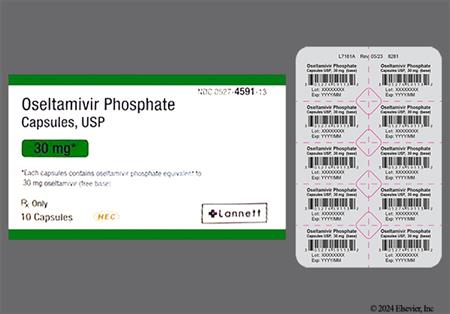
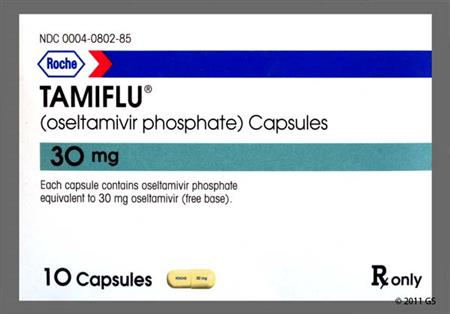
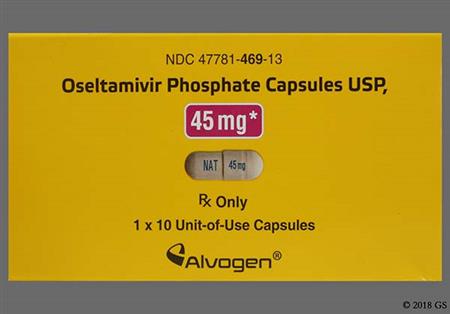
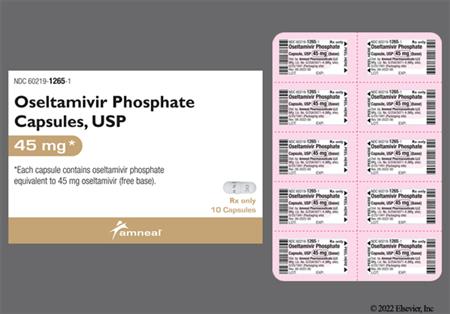
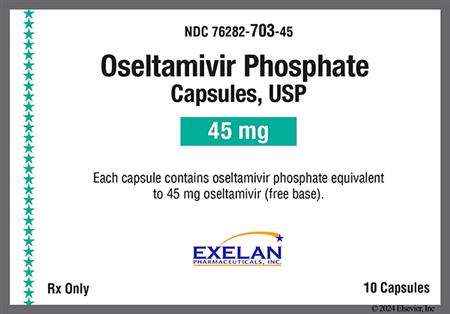
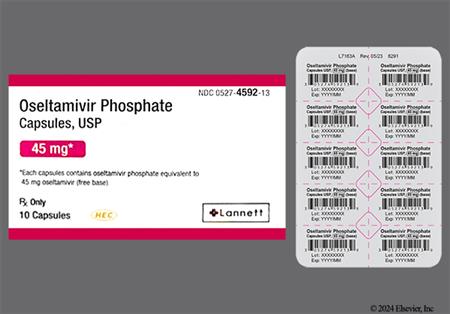
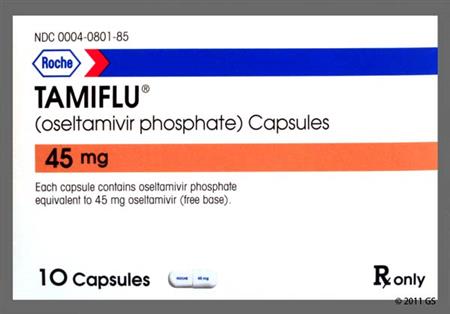
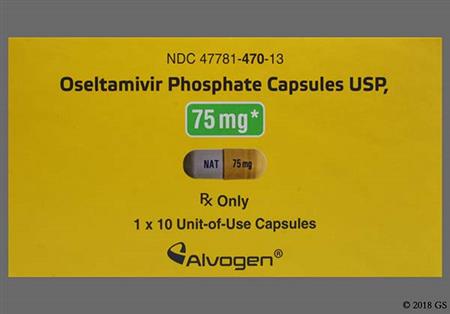
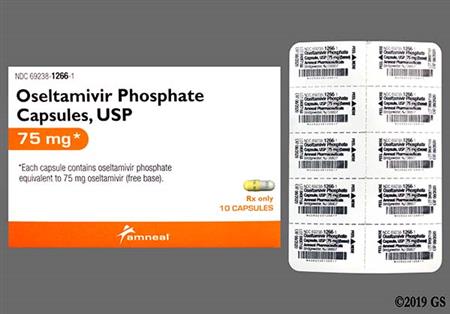
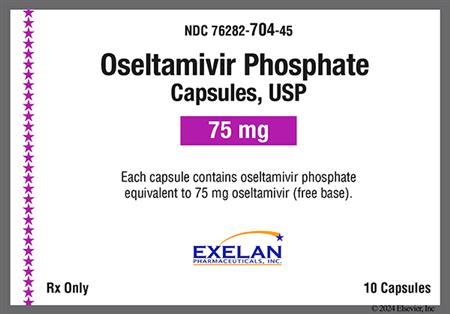
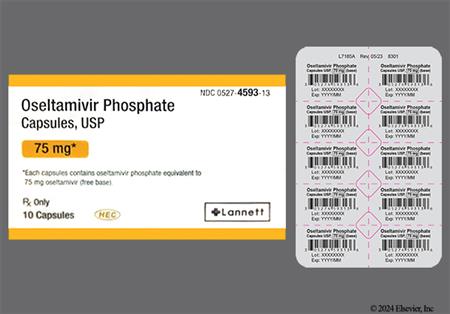
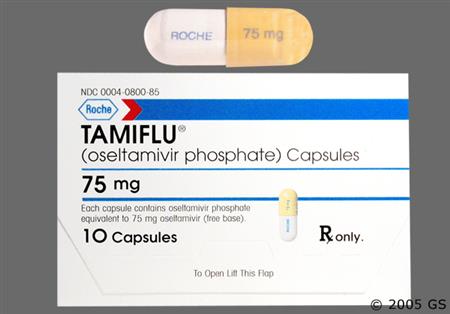
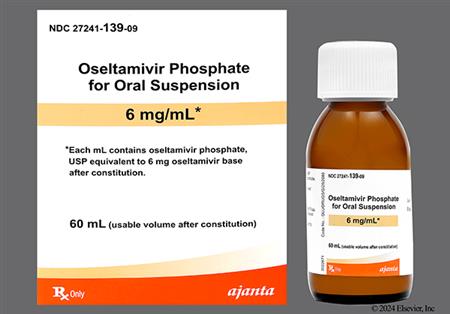
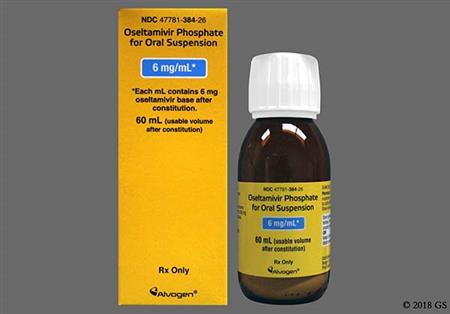
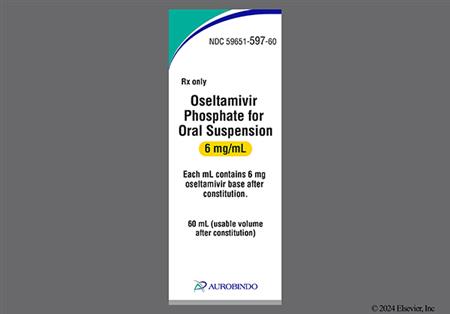


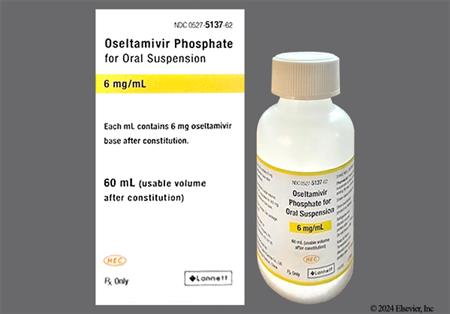
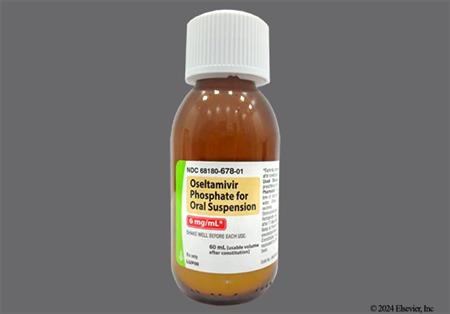
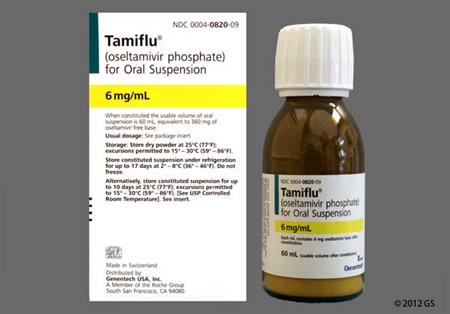
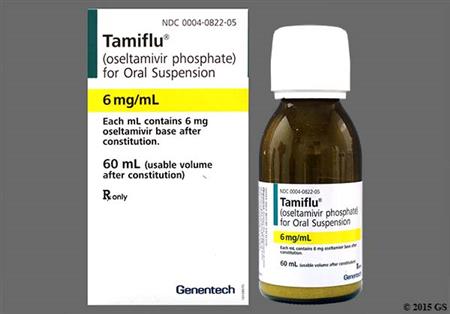
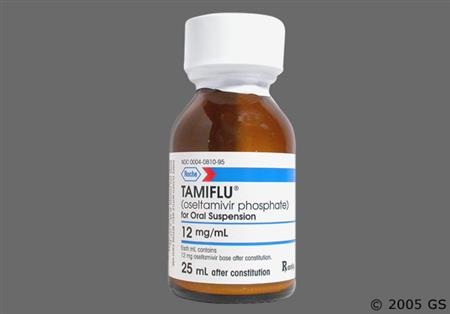
Oseltamivir is an oral neuraminidase inhibitor (NAI) indicated for the treatment and prevention of acute, uncomplicated seasonal influenza infections. Like other NAIs (zanamivir and peramivir), oseltamivir has activity against both influenza A and B viruses; whereas adamantanes (amantadine and rimantadine) are active against influenza A only.[52875] Clinical benefit from antiviral therapy is greatest when initiated early; therefore, the FDA-approved labeling recommends initiating oseltamivir within 48 hours of influenza symptom onset (for treatment) or close contact with an infected individual (post-exposure prophylaxis).[31109] However, according to the Centers for Disease Control and Prevention (CDC), specific patient populations (including those with severe, complicated, or progressive illness, pregnant women of any trimester, and hospitalized patients) may still receive benefit from antiviral treatment if initiated after 48 hours of illness onset. Oseltamivir is not considered a substitute for annual influenza virus vaccination. Instead, NAI antiviral drugs are considered adjuncts to the prevention and control of influenza; annual influenza vaccination remains the main option for reducing the impact of influenza.[62315][63866] Oseltamivir was FDA-approved in 1999.[31109]
For storage information, see the specific product information within the How Supplied section.
Reconstitution of commercially available 6 mg/mL oral suspension
Administration
Extemporaneous compounding instructions for oseltamivir oral suspension (6 mg/mL)
The most frequent adverse effects associated with oseltamivir are nausea and vomiting, which usually occur during the first 2 days of treatment. Vomiting was reported more frequently in both pediatric patients and adults who received the twice daily treatment dose compared with the once daily prophylactic dose. In adults, vomiting was reported in 8% with 75 mg twice daily and 2% with 75 mg once daily; the respective numbers for children were 16% and 8%. Nausea was also reported with treatment doses (10% of adults) and prophylactic doses (8% adults). Vomiting (9%) and diarrhea (7%) were the most common GI adverse reactions reported in treatment studies in infants younger than 1 year of age. Oseltamivir may be taken with or without food, but tolerability may be enhanced if it is taken with food. Dyspepsia and diarrhea may occur in patients with hereditary fructose intolerance and using oseltamivir powder for oral suspension because of the sorbitol content. Elevated hepatic enzymes, hepatitis, GI bleeding, and hemorrhagic colitis have been noted in postmarketing reports.[31109]
Dermatologic reactions observed with oseltamivir include rash, dermatitis, eczema, and urticaria. Diaper dermatitis was reported in 7% of infants younger than 1 year of age receiving oseltamivir in clinical trials. Anaphylactoid reactions, such as anaphylactic shock and swelling of face or tongue (laryngeal edema or angioedema), and serious skin reactions, such as toxic epidermal necrolysis, Stevens-Johnson syndrome, and erythema multiforme, have been reported in postmarketing experience with oseltamivir. Stop oseltamivir and institute appropriate treatment if an allergic reaction or suspected allergic reaction occurs.[31109]
Neuropsychiatric adverse reactions, including self-injury, delirium (psychosis), abnormal behavior or emotional lability, hallucinations, agitation, anxiety, altered consciousness, confusion, nightmares, and delusions, have been reported with oseltamivir in postmarketing surveillance. These events were primarily reported in pediatric patients and often occurred abruptly and resolved rapidly. Influenza infection itself may be associated with a variety of neurologic and behavioral symptoms; while symptoms may occur in the setting of encephalitis or encephalopathy, they can occur without obvious severe disease. The relative contribution of oseltamivir to the postmarketing reports of neurological symptoms is not known. Closely monitor patients with influenza who are receiving oseltamivir for signs of abnormal behavior. If neuropsychiatric events occur, evaluate the risks and benefits of continuing oseltamivir.[31109] A review of data from controlled clinical trials and ongoing surveillance has failed to confirm a link between oseltamivir and psychiatric effects.[63520] In a retrospective study in infants younger than 12 months of age, neurologic adverse reactions were not more common with oseltamivir compared with amantadine and rimantadine.[52876] Seizures have also been noted in postmarketing reports.[31109]
Headache (17%) was commonly reported in oseltamivir prophylaxis studies that included adult and adolescent patients; headache was less frequent (2%) in treatment trials. Generalized pain was reported in up to 4% of patients in prophylaxis studies.[31109]
Arrhythmia exacerbation, aggravation of diabetes (hyperglycemia), and hypothermia have been noted in postmarketing reports with oseltamivir.[31109]
The coadministration of certain medications may lead to harm and require avoidance or therapy modification; review all drug interactions prior to concomitant use of other medications.
This medication is contraindicated in patients with a history of hypersensitivity to it or any of its components.
There are no data to suggest oseltamivir is effective in treating illness caused by pathogens other than influenza viruses A and B. The drug is most effective when initiated within 48 hours of symptom onset or close contact with an infected individual; however, limited data suggest antiviral therapy may still be beneficial to high risk patients when initiated up to 5 days after illness onset. Some patients may develop serious bacterial infections that begin with influenza-like symptoms, or may coexist with or occur as complications of influenza. Oseltamivir has not been shown to prevent such complications. Monitor patients for secondary bacterial infections and treat with antibiotics as clinically warranted.[31109][62315]
Antiviral medications with activity against influenza, such as oseltamivir, are not substitutes for receipt of an annual influenza vaccination; these medications should be used as an adjunct to the vaccine in the control of influenza. Oseltamivir does not interfere with the antibody response to the inactivated influenza vaccine; however, there is concern about possible interference with the viral replication necessary after administration of the live attenuated influenza vaccine for the proper development of immunity. Do not administer the live attenuated influenza vaccine within 48 hours after oseltamivir administration, and wait at least 2 weeks after administration of the live attenuated vaccine to begin oseltamivir therapy, unless earlier oseltamivir therapy is medically necessary.[31109]
The efficacy of oseltamivir for the treatment or prophylaxis of influenza in patients with immunosuppression has not been established, and selection of oseltamivir-resistant influenza viruses may occur at higher frequencies in these patients. However, the safety of oseltamivir for prophylaxis of influenza has been demonstrated for up to 12 weeks in immunocompromised patients.[31109] The Centers for Disease Control and Prevention (CDC) recommends oseltamivir for the treatment and prevention of influenza in patients with immune deficiencies and those receiving immunosuppressive medications.[62315]
Use oseltamivir with caution in patients with renal impairment, including those with renal failure. Exposure to oseltamivir carboxylate increases as renal function declines, which may increase the risk of adverse reactions. Dosage adjustments are recommended for patients with moderate or severe renal impairment (creatinine clearance 60 mL/minute or less) and for those with end-stage renal disease (ESRD, defined as creatinine clearance 10 mL/minute or less) undergoing hemodialysis or peritoneal dialysis. Oseltamivir is not recommended for patients with ESRD who are not undergoing dialysis.[31109]
Pregnant and postpartum individuals are at significantly higher risk for serious complications from influenza infection as compared with nonpregnant people; therefore, timely use of antiviral therapy is recommended for the treatment and post-exposure prevention of influenza. Guidelines consider oseltamivir the preferred antiviral for treatment of influenza in pregnant individuals and recommend oseltamivir for post-exposure prophylaxis in pregnant individuals who have had close contact with infectious individuals. No adequate and well-controlled studies have been conducted regarding the use of oseltamivir during pregnancy; however, a collection of observational studies have evaluated drug exposure in more than 5,000 pregnant individuals. Although, individually, these studies lacked adequate sample size, pooled data found no increased risk of congenital malformations when compared to the general population. In addition, the gestational period in which exposure occurred appeared to have no effect on pregnancy outcome, as approximately 1,000 individuals were exposed during the first trimester. In animal studies, slight and marked maternal toxicities and a dose-dependent increase in skeletal abnormalities in offspring were observed.[28647] [31109] [62315] [70419]
Oseltamivir is compatible with breast-feeding. Limited data suggest oseltamivir and oseltamivir carboxylate are excreted in human breast milk at low concentrations; however, exposure through breast milk is unlikely to lead to toxicity in the breastfed child. The concentration of oseltamivir and oseltamivir carboxylate in breast milk was found to be lower than the concentrations in plasma following a single 75 mg oral dose. The estimated infant exposure to oseltamivir, assuming a 2.75 kg infant receiving 750 mL of breast milk daily, was 0.76 mcg/kg/day. Postmarketing experience has not reported any information to suggest serious adverse effects of oseltamivir exposure via breast milk in infants. It is not known if oseltamivir affects human milk production. Consider the developmental and health benefits of breast-feeding along with the mother's clinical need for oseltamivir and any potential adverse effects on the breastfed child from the drug or from the underlying maternal condition.[31109] [46321] [70364]
Oseltamivir for oral suspension contains sorbitol, which can be harmful to patients with hereditary fructose intolerance. Each 75 mg dose delivers 2 grams of sorbitol, exceeding the daily maximum limit for these patients and potentially causing dyspepsia and diarrhea. Consider using alternative formulations or avoiding use in patients with hereditary fructose intolerance.[31109]
Oseltamivir is an ethyl ester prodrug that requires hydrolysis to the active metabolite, oseltamivir carboxylate. Once in circulation, oseltamivir carboxylate acts extracellularly by selectively binding to an unoccupied area of viral neuraminidase (a surface glycoprotein on influenza A and B that catalyzes the cleavage of the linkage between a terminal sialic acid and adjacent sugar residue), resulting in competitive inhibition of the enzyme. By inhibiting the actions of viral neuraminidase, oseltamivir ultimately prevents the spread of virus in the respiratory tract.[31109][62315]
Influenza viruses are classified into 3 distinct types, influenza A, influenza B, and influenza C. Influenza A is further divided into subtypes based on their hemagglutinin (H or HA) and neuraminidase (N or NA) activity. At least 16 distinct HAs (H1 to H16) and 9 NAs (N1 to N9) have been described. Influenza infection may be attributed to either influenza A virus or influenza B virus. Influenza A virus subtypes include H1N1 and H3N2. In 2009, a novel influenza A H1N1 virus (previously referred to as swine influenza) was identified; this virus is included in season influenza A viruses. Human cases of influenza illness from the avian H5N1 virus (commonly known as avian flu) have been reported since 1997. Human infections with avian H7N9, H5N2, H5N8, H9N2, H7N7, and H7N3 viruses have also been described.[36906][62337]
A neuraminidase assay of clinical isolates identified the median IC50 (50% inhibitory concentration) for oseltamivir carboxylate against influenza A/H1N1, influenza A/H3N2, and influenza B to be 2.5 nM (range 0.93 to 4.16 nM), 0.96 nM (range 0.13 to 7.95 nM), and 60 nM (range 20 to 285 nM), respectively. An evaluation of antiviral activity using laboratory and clinical influenza isolates found the concentrations of oseltamivir carboxylate required for inhibition of influenza virus in cell culture to be highly variable depending on the assay method used and virus testing. Specifically, the EC50 and EC90 (50% and 90% effective inhibitory concentration) of these cell cultures ranged from 0.0008 micromolar to more than 35 micromolar and 0.004 micromolar to more than 100 micromolar, respectively. A relationship between antiviral activity in cell culture, inhibitory activity in neuraminidase assay, and inhibition of influenza virus replication in humans has not been established. Influenza treatment emergent resistance to oseltamivir has been reported, with most cases occurring in influenza A/H1N1 viruses. Genetic analysis shows that reduced susceptibility to oseltamivir carboxylate is associated with mutations that result in amino acid changes in the viral neuraminidase or viral hemagglutinin or both. The prevalence of oseltamivir-resistant viruses varies based on season and geographic location. Severely immunosuppressed persons (e.g., hematopoietic stem cell transplant recipients) are at highest risk for developing an oseltamivir-resistant influenza virus infection during or after antiviral therapy. In addition, selection of influenza A viruses resistant to oseltamivir appears to occur at higher frequencies in pediatric populations. During small pediatric studies, the incidence of oseltamivir treatment-associated resistance for influenza A/H1N1 and influenza A/H3N2 were 27% to 37% and 3% to 18%, respectively. The actual risk of resistance to oseltamivir during clinical use cannot be determined from these small pediatric studies. The CDC Influenza Division is available for consultation regarding resistance testing as needed.[31109][62315]
Revision Date: 10/17/2025, 05:17:59 PMOseltamivir is administered orally. After absorption from the gastrointestinal tract, most of the dose (at least 90%) is hydrolyzed by hepatic esterase to the active metabolite, oseltamivir carboxylate. Oseltamivir carboxylate does not undergo any further metabolism and is only minimally bound to human plasma proteins (3%). The drug is widely distributed into body tissues and fluids, including saliva, nasal mucosa, lung, and middle-ear fluid.[52950] The elimination half-life of oseltamivir carboxylate is 6 to 10 hours, with more than 99% being eliminated in the urine via glomerular filtration and active tubular secretion. The elimination half-life of the parent drug is 1 to 3 hours.[31109]
Affected cytochrome P450 isoenzymes and drug transporters: none
Neither oseltamivir nor oseltamivir carboxylate are substrates for, or inhibitors of, cytochrome P450 isoenzymes.[31109]
Oseltamivir is readily absorbed from the gastrointestinal tract. After oral administration, 75% of the dose reaches systemic circulation as oseltamivir carboxylate; less than 5% of the total dose reaches the systemic circulation as oseltamivir. Administration with food has no significant effect on the Cmax or AUC values for oseltamivir carboxylate.[31109] Oseltamivir suspension and capsules have been found to be bioequivalent for the active metabolite in healthy adults.[52953]
In adult patients with mild or moderate hepatic impairment, oseltamivir carboxylate systemic exposure was not altered; pharmacokinetics in patients with severe hepatic impairment have not been evaluated.[31109]
In patients with decreased renal function, oseltamivir carboxylate exposure is inversely proportional to declining renal function. Adult patients with renal impairment who received the manufacturer recommended dosage adjustments based on creatinine clearance, had pharmacokinetic exposure parameters (i.e., Cmax, Cmin, AUC) that were similar to those observed in patients with normal renal function. Patients with renal failure (creatinine clearance less than 10 mL/minute) not undergoing dialysis have not been studied.[31109]
Continuous ambulatory peritoneal dialysis (CAPD)
In adult CAPD patients, the Cmax of oseltamivir carboxylate following a single 30 mg dose of oseltamivir or once weekly oseltamivir was approximately 3-fold higher than in patients with normal renal function who received 75 mg twice daily. The plasma concentration of oseltamivir carboxylate on Day 5 (147 ng/mL) following a single 30 mg dose in CAPD patients is similar to the predicted Cmin (160 ng/mL) in patients with normal renal function following 75 mg twice daily. Administration of 30 mg once weekly to CAPD patients resulted in plasma concentrations of oseltamivir carboxylate at the 168-hour blood sample of 63 ng/mL, which were comparable to the Cmin in patients with normal renal function receiving the approved regimen of 75 mg once daily (40 ng/mL).[31109]
In elderly patients (age 65 to 78 years), oseltamivir carboxylate exposures at the steady-state AUC were 25% to 35% higher than values observed in younger patients given comparable oseltamivir doses. However, the observed half-lives were similar between the two groups, and no dosage adjustments were required.[31109]
Pregnancy
Although data are insufficient to recommend dosage adjustments, an analysis of pooled pharmacokinetic parameters found exposure to the active metabolite of oseltamivir to be lower in pregnant individuals (n = 59) than in non-pregnant individuals (n = 33). Drug exposures in pregnant individuals are expected to be high enough to maintain activity against susceptible influenza virus strains.[31109]
Pregnant and postpartum individuals are at significantly higher risk for serious complications from influenza infection as compared with nonpregnant people; therefore, timely use of antiviral therapy is recommended for the treatment and post-exposure prevention of influenza. Guidelines consider oseltamivir the preferred antiviral for treatment of influenza in pregnant individuals and recommend oseltamivir for post-exposure prophylaxis in pregnant individuals who have had close contact with infectious individuals. No adequate and well-controlled studies have been conducted regarding the use of oseltamivir during pregnancy; however, a collection of observational studies have evaluated drug exposure in more than 5,000 pregnant individuals. Although, individually, these studies lacked adequate sample size, pooled data found no increased risk of congenital malformations when compared to the general population. In addition, the gestational period in which exposure occurred appeared to have no effect on pregnancy outcome, as approximately 1,000 individuals were exposed during the first trimester. In animal studies, slight and marked maternal toxicities and a dose-dependent increase in skeletal abnormalities in offspring were observed.[28647] [31109] [62315] [70419]
Oseltamivir is compatible with breast-feeding. Limited data suggest oseltamivir and oseltamivir carboxylate are excreted in human breast milk at low concentrations; however, exposure through breast milk is unlikely to lead to toxicity in the breastfed child. The concentration of oseltamivir and oseltamivir carboxylate in breast milk was found to be lower than the concentrations in plasma following a single 75 mg oral dose. The estimated infant exposure to oseltamivir, assuming a 2.75 kg infant receiving 750 mL of breast milk daily, was 0.76 mcg/kg/day. Postmarketing experience has not reported any information to suggest serious adverse effects of oseltamivir exposure via breast milk in infants. It is not known if oseltamivir affects human milk production. Consider the developmental and health benefits of breast-feeding along with the mother's clinical need for oseltamivir and any potential adverse effects on the breastfed child from the drug or from the underlying maternal condition.[31109] [46321] [70364]
Cookies are used by this site. To decline or learn more, visit our cookie notice.
Copyright © 2025 Elsevier, its licensors, and contributors. All rights are reserved, including those for text and data mining, AI training, and similar technologies.